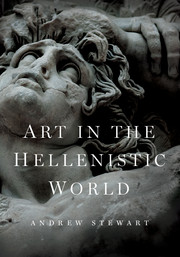Book contents
- Frontmatter
- Contents
- List of Illustrations
- Preface
- Introduction
- 1 Settlement
- 2 Power
- 3 Victory
- 4 Benefaction
- Focus I The Great Altar of Pergamon
- Focus II Hellenistic Mosaics
- Appendix A The Artist
- Appendix B Kallixeinos of Rhodes on the Wonders of Alexandria
- Glossary
- Timeline
- Biographical Sketches
- Select Bibliography and Further Reading
- References
- Sources of Illustrations
- Index
Appendix A - The Artist
Published online by Cambridge University Press: 05 October 2014
- Frontmatter
- Contents
- List of Illustrations
- Preface
- Introduction
- 1 Settlement
- 2 Power
- 3 Victory
- 4 Benefaction
- Focus I The Great Altar of Pergamon
- Focus II Hellenistic Mosaics
- Appendix A The Artist
- Appendix B Kallixeinos of Rhodes on the Wonders of Alexandria
- Glossary
- Timeline
- Biographical Sketches
- Select Bibliography and Further Reading
- References
- Sources of Illustrations
- Index
Summary
ARTIST AND CRITIC REVISITED
At first sight, Hellenistic art looks like the product of runaway artistic virtuosity and untrammeled self-assertion. Paradoxically, though, we know far less about Hellenistic artists than about their classical predecessors, and the ancient critics usually judged them inferior to the latter. This prejudice infected Winckelmann and his followers (see the Introduction), and it still thrives today. As we saw in Chapter 12, it is most clearly articulated in Pliny’s history of Greek bronze statuary, which allegedly “ceased” in 293 and was revived again only in 156 at the hands of “inferiors.” Yet Quintilian also thought that both painting and sculpture languished after 300, and Pausanias’s patience with Hellenistic art (the classicizing Damophon’s work apart: Figures 94–95) is short compared with his fondness for the classical.
These critics all regarded the classical style as art’s predestined climax and promoted its revival. Neoclassical prejudice of this kind, fueled by the practice of collecting and the canonization of “Old Masters” such as the fifth-century Athenian sculptor Pheidias (see Figure 167), sought to consign the baroque (Figures 8, 46, 57–60, etc.) and other non-classicizing or insufficiently classicizing work – both artistic and literary – to oblivion (see Box 1: “Classicism and the Baroque”). In this vein, A. W. Lawrence, the author of an early study of Hellenistic sculpture, once wittily invoked the nineteenth-century British Pre-Raphaelites. Their catalogue of paintings in the Louvre dismissed Raphael as “slosh,” called his successors “filthy slosh,” and stridently championed medieval art instead. (The ancient critics usually were more polite. They simply ignored what they disliked.)
- Type
- Chapter
- Information
- Art in the Hellenistic WorldAn Introduction, pp. 285 - 293Publisher: Cambridge University PressPrint publication year: 2014



